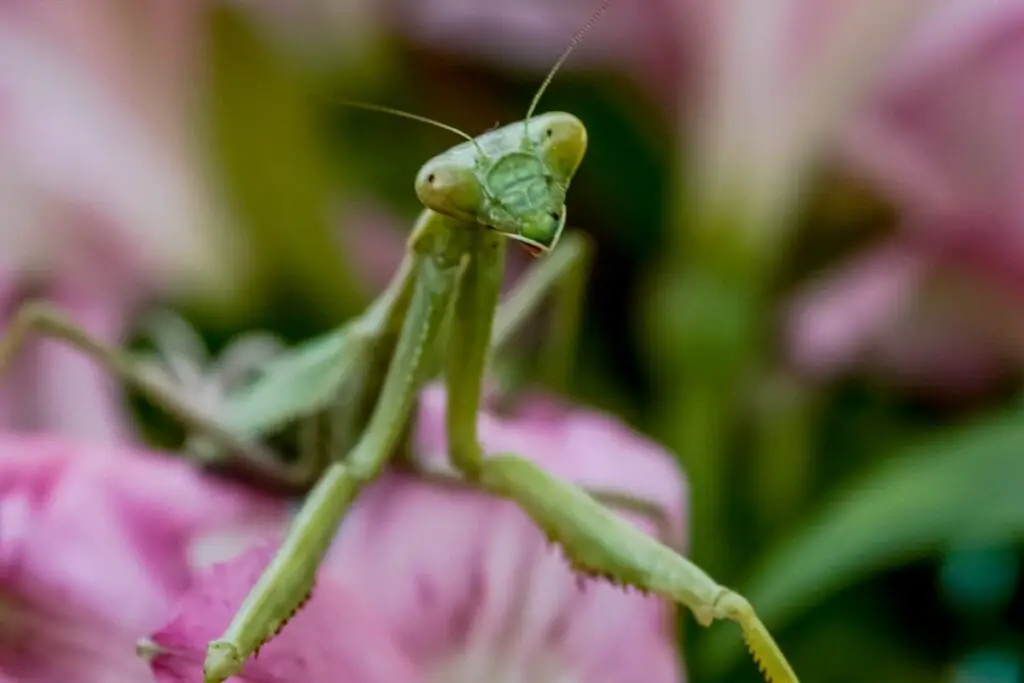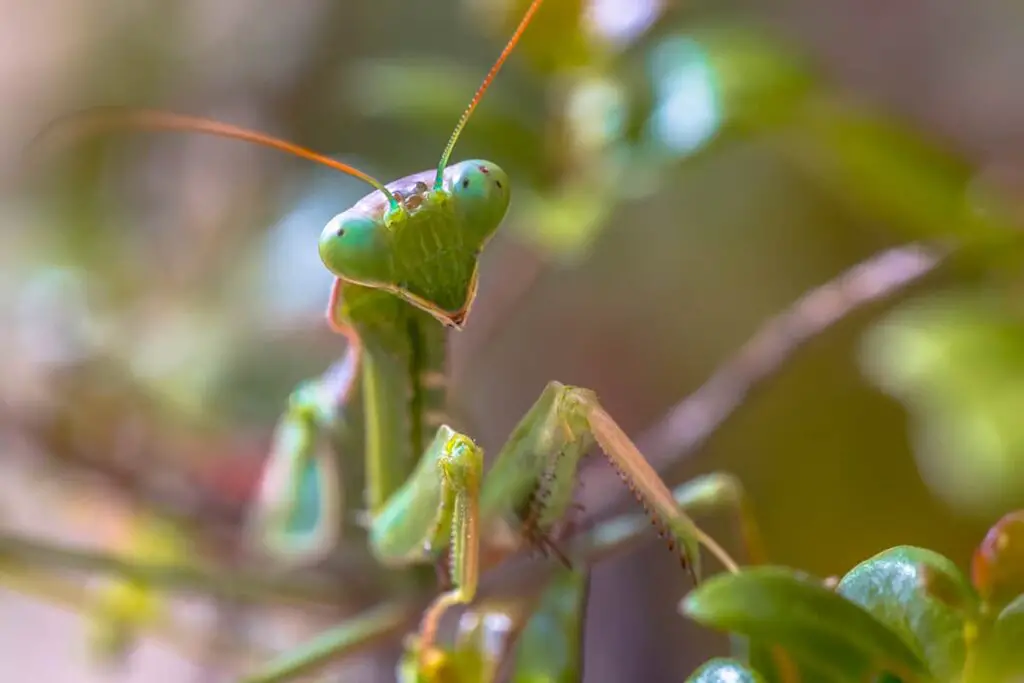Creating an outdoor habitat for a praying mantis can be a rewarding experience for any insect enthusiast. You’ll provide a beneficial predator with a comfortable home, and in turn, your garden may benefit from the natural pest control that mantises offer. Setting up the habitat correctly is crucial for the health and happiness of your praying mantis. It requires attention to detail, from choosing the right container to maintaining the proper environmental conditions.
The key to a successful mantis habitat is replicating the insect’s natural environment as closely as possible. This involves understanding the specific needs of mantises, such as space to roam and hunt, as well as appropriate places for them to molt and rest. In an outdoor habitat, you need to consider factors like exposure to natural light, protection from the elements, and access to food sources.
Remember, mantises thrive in environments that mimic their natural living conditions. Whether you’re looking to observe these fascinating creatures or want to bolster your garden’s defense against pests, the proper set-up of your mantis habitat is a vital first step. Following clear, straightforward instructions will ensure your mantis has a hospitable outdoor home where it can grow and contribute positively to your local ecosystem.
Choosing the Right Location
Before creating an outdoor habitat for your praying mantis, it’s essential to select an optimal location considering your local climate, the habitat’s accessibility, and the balance between sunlight and shade.
Climate Considerations
Your region’s climate is a critical factor in situating your mantis habitat. If you live in an area with extreme temperatures, you’ll need a spot that can provide insulation during cold spells and cooling shade during heat waves. Mantises thrive in temperatures between 70°F to 85°F and require protection from harsh environmental conditions.
Accessibility and Safety
Ensure the habitat is positioned where you can easily monitor and maintain it. It should be safely away from pets and wild animals that might disturb or harm your mantis. Consider placing the habitat at a height that is out of reach of predators, and in a location that doesn’t pose a tripping risk for passersby.
Sunlight and Shade
Your mantis habitat needs a delicate balance of light. Aim for a location that receives bright indirect light for much of the day, to mimic natural day-night cycles. Avoid direct sunlight which can overheat the habitat, but also steer clear of complete darkness. An ideal spot might be under a tree where sunlight filters through or on the side of a structure that gets partial daylight.
Designing the Habitat
Creating an inviting outdoor habitat for your praying mantis is crucial to ensure it stays healthy and active. Thoughtful planning is key to mimic their natural environment closely.
Size and Space Requirements
Your mantis requires space to roam and hunt. A good rule of thumb is to use a container that’s at least three times the length of your mantis, and twice the width to allow for proper movement and molting. Ensure the habitat provides adequate vertical space for climbing, as mantises like to perch high and ambush their prey.
Plants and Vegetation
Plants are an essential component of the mantis habitat. They offer hiding spaces, hunting grounds, and contribute to the overall humidity of the environment. Include live plants such as marigolds or tall grasses that attract insects, providing a hunting ground for your mantis. Ensure the plants are nontoxic and allow for sufficient perching spots.
Soil Composition
The base layer of your habitat should consist of soil or a soil-like substrate, aiding in maintaining moisture levels and providing a substrate for live plants. It should be loose enough to allow for easy movement of the mantis but firm enough to support plant life. Avoid chemicals and fertilizers that can harm your mantis, and choose natural, organic options when possible.
Building the Structure
Creating a suitable outdoor habitat for your praying mantis is essential for their health and well-being. You’ll be building a secure and conducive space that mimics their natural environment.
Materials and Tools
Before starting the construction, gather the necessary materials and tools. You will need:
- Mesh or screen for ventilation
- Glass or plastic sheets for the walls
- Sticks or plants for the mantis to climb
- Soil for the base (optional)
- Drill with bits for making ventilation holes
- Saw for cutting materials to size
- Screws or adhesive for assembly
- Thermometer and humidity gauge to monitor the environment
For specific material sizes and types, visit How to Set up a Praying Mantis Habitat or Praying Mantis Habitat – Terrarium Station.
Step-by-Step Construction
To construct the habitat, follow these steps:
-
Measure and Cut: Based on the dimensions required, cut the glass or plastic sheets for the walls. Your enclosure should be at least 18 inches tall and 12 inches wide.
-
Ventilate: Drill holes in the sides or attach a mesh screen to the top to provide adequate ventilation.
-
Assemble Walls: Join the walls using screws or a strong adhesive. Ensure it’s secure to protect your mantis from predators and to prevent escape.
-
Install Climbing Structures: Place sticks diagonally across the enclosure or live plants to create a natural environment for your mantis to explore and molt.
-
Monitoring Setup: Place a thermometer and humidity gauge inside the habitat to keep track of temperature and moisture levels.
Detailed guidance for assembling mantid habitats can be found at DIY Complete mantid habitat construction tutorial guide.
Remember, always keep the habitat out of direct sunlight and harsh weather conditions to ensure the safety and health of your praying mantis.
Maintenance and Care
Proper maintenance and care of your outdoor mantis habitat is essential to ensure the health and well-being of your praying mantises. Attention to feeding, seasonal adjustments, and predator prevention will keep your little predators thriving.
Feeding and Watering
Feeding: Your mantis will thrive on a diet of live insects. Offer appropriately sized prey such as fruit flies for smaller nymphs and move on to larger insects like crickets or moths as your mantis grows. Feed young mantises daily and adults every 2-3 days.
Watering: Lightly mist the interior of your mantis habitat every day to maintain the necessary humidity levels. Mantises drink water droplets from foliage, so ensure that plants within the enclosure are also misted.
Seasonal Adjustments
Temperature Management: As the seasons change, you’ll need to adjust the habitat’s temperature. Keep the habitat warm, ideally between 75°F and 85°F during the day, with a slight drop at night. Use a heating pad if necessary, especially in colder months.
Humidity Control: Maintain the humidity level at around 40-60%. This might require more frequent misting during dry seasons or the use of a humidifier.
Predator Prevention
Secure Enclosure: Ensure your mantis habitat is secure to protect from predators like birds or rodents. Check for any gaps or holes and repair them immediately.
Placement: Place the habitat out of reach of pets and in a location that minimizes the risk of predatory insects entering.
Remember, a well-maintained habitat is key to your mantis’s longevity and health.
Frequently Asked Questions
Creating an effective outdoor praying mantis habitat involves understanding their living requirements and behavioral patterns. Here’s how you can get started.
What are the essential components to include when creating a praying mantis habitat?
Your praying mantis habitat should have ample vegetation for hiding and hunting, such as shrubs or tall plants. A source of water, like a shallow dish, is also necessary for hydration.
How do you properly set up an enclosure for a praying mantis?
To set up a praying mantis enclosure, ensure it’s at least three times the length of the mantis and twice the width. Include sticks or plants for climbing and moulting, and a secure lid to prevent escapes.
What is the ideal location to place a mantis habitat outdoors?
Position your mantis habitat in a spot that receives a mix of sunlight and shade throughout the day. Avoid locations with strong winds and heavy foot traffic to minimize disturbances.
How can I attract and keep praying mantises in my garden?
Attract praying mantises to your garden by planting a variety of flowering plants and having a diverse garden ecosystem, which provides them with plenty of prey.
Can you provide tips for beginners on building an outdoor mantis habitat?
For beginners, it’s crucial to understand that mantises need space to hunt and features to mimic their natural environment. Using untreated wood and mesh for construction can create a suitable outdoor habitat.
What materials are needed to construct a suitable habitat for praying mantises?
Constructing a mantis habitat typically requires fine mesh or netting for ventilation, untreated wood for the structure, secure fittings to keep the habitat intact, and natural elements like plants and branches for the mantises to thrive.
Driven by a passion for those tiny creatures that rule our world, we at Bug Domain strive to be your go-to resource for information on insects.




